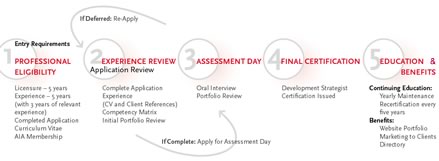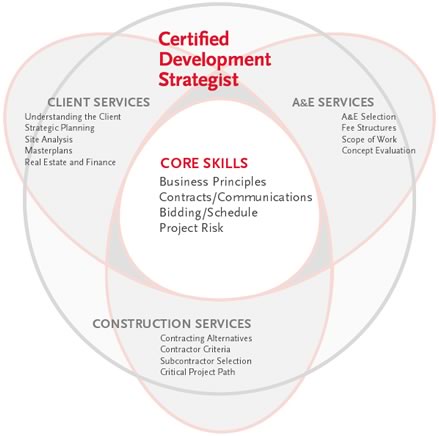

Associate Editor
"Advancement of architecture as a profession is dependent upon architects themselves constantly striving to improve," according to the "Client Outlook, 2002" research.
Now, a new certification program in California, organizers say, is helping architects document and advertise expertise that extends beyond traditional design services to respond to client needs.
AIA California Council unveiled earlier this year a certification program for architects that will signify an architect's proficiency in a range of areas and help architects market an expanding palette of services. The AIACC Certification Program for Development Strategists would denote a design professional's ability to serve a client from the development stage through design and construction.
"Increasingly, architects are responsible for guiding their clients in the development of facility options, from funding to real estate to design construction and post-occupancy requirements," said Gordon N. Park, AIA, AIACC vice president of communications and public affairs and chair of the AIACC certification program.
"In the traditional role, an architect enters the development process midstream, responding to the client's request for a proposal. The AIACC certified development strategist is able to help the owner develop a more holistic approach, and is qualified to serve as the client's trusted advisor throughout the entire process, assuring a predictable development outcome," Park said. "From the initial concept to design, financing, real estate evaluation and programming, the CDS [certified development strategist] brings a whole new perspective and approach to strategic management."

Becoming a CDS
The certification program is a competency-based assessment process. The
CDS program is available to any AIA member who has been professionally
registered at least five years and has three years of experience relevant
to the CDS role. Once they have confirmed that an applicant has these
qualifications, AIACC staff and a panel of professional advisors review
the application materials.
After their eligibility review is completed, architects may register for a portfolio assessment, the next step in the certification process. If the architect does not meet initial eligibility requirements, he or she receives a detailed summary of areas that need further attention and a list of resources that can help bring them up to speed.
For people ready to move on, the next assessment is an oral examination of knowledge, experience, and skills. Panel members ask a series of questions addressing four skill and competency areas and test the applicant's ability to apply their competencies in practical situations. This presentation allows the panel to review the applicant's thought processes, presentation ability, experience, and education. Architects are asked to provide samples of their work in support of their oral presentations.
The cost of the certification includes a nonrefundable $275 application fee, a $375 nonrefundable assessment fee, and a $100 certificate fee.
The first three architects to be certified graduated from the program in March. Hundreds more have asked for an application for the next certification cycle, and about a third of the applicants are outside California. AIACC publishes the name and contact information for the people who have passed the assessment.

Putting the program
together
Clients understand that architects have more than just expertise in design;
that they value an architect's education, three-dimensional thinking,
problem-solving, and strategic outlook on how a project can be accomplished,
said AIACC Executive Vice President Paul Welch, Hon. AIA.
The program has roots going back some years, noted AIACC President Carl F. Meyer, AIA, who described Welch as the "keeper of the flame." The idea started to resonate late in the 1990s in tune with the national AIA AIM initiatives and the call among clients and architects alike for expanded services. The idea was nurtured, Meyer said, at one of the Council's leadership retreats. "It was at that point that Paul Welch and I basically committed to moving this agenda forward," he said.
Meyer explained that it took two years to make the certification program what it is now. To date, the AIACC has invested about $150,000 to develop the program. The Council had developed a steering group, a task force to develop curriculum, and other committees and conducted focus groups with clients and others to refine the agenda.
Welch said the Council spent a lot of time meeting with clients and other experts to test and develop the curriculum. The certification assesses three levels of understanding, Welch said: awareness (knowledge of a particular topic), understanding (fitting that knowledge into the larger picture), and ability (putting the knowledge to work for a client).

A larger vision
"What actually makes the certification meaningful is partially the
AIA brand and partially that it is based on a platform of licensed architects,"
Meyer said. "But I think it is mostly because of another part of
our program—the real heart of our program—which is the Academy."
The certification program exists within the Academy of Strategic Planning and Development, which is part of the Institute of Advanced Education and Practice. Reaching beyond the AIA family, the Academy aims to bring together all the expertise in the various aspects of development strategy, collecting knowledge from a wide range of experts, including academia, industry, finance, and client groups.
Meyer said the whole process of certification within the program "represents the possibility of really creating careers in the field that are uniquely bundled together."
"It's the intellectual capital that is developed within the Academy that allows our certified development strategists to be on the leading edge in the field. So when we certify someone, that's not the end of it, that's just the beginning of their involvement," Meyer said.
"That's crucial for us," he said, "because otherwise the certification program is a rubber stamp, which may give architects a competitive advantage over those who are not certified. But does it really give them the kind of intellectual stimulation, that kind of leadership position that we would like to have in the world of built environments?"
Both Welch and Meyer agree that the program does have liability implications for the Council, but have taken measures to mitigate them.
"Anything of value has consequences. By having a strict process for certification, the organization's exposure to liability is reduced," Welch said. He noted that from early on this has been a serious effort with a well-defined and solid foundation.
Meyer added that one of the biggest endorsements for the programs has been from their insurers, which have given financial support to help develop the program. "I think the liability issues are, if anything, much less than for traditional architecture practice because there are no standards for this kind of work outside architecture. We're actually bringing a higher level of rigor to that process and take more responsibility for it," Meyer said.
Validation
"When I saw the program from the AIACC, it seemed like a perfect
way to give credibility to our expertise in this area and to validate
that we are, in fact, qualified to do development consulting," said
William Kortsch, AIA, CDS, one of the first architects to receive certification.
Kortsch, vice president of RGA Landscape Architects, Inc., who has more than 20 years of experience in architecture and land planning and some experience in the type of consulting the CDS program describes, said that developers may be "reticent to trust you" because development often involves large sums of money. He also said certification helps developers determine who is qualified to assist them.
"I think that the missing piece from doing more of this type of consulting work with owners was an element of validation," Kortsch said.
Kortsch, who has a practice that focuses on resorts, golf-oriented resort communities, high-end custom residences, low-rise commercial buildings, and retail shopping centers, and who has done some development work, said he found the certification process "challenging."
Welch agreed that a positive CDS assessment gives "leverage" to architects to improve their positions in their own firm and in the business and development community at large.
Meyer said members sometimes question why they need to become certified, thinking it is just an impediment rather than an advantage. He says he explains the role of the academy in promoting leadership in the field and staying at the forefront of research and practice. Once this connection is made, he said, certification then becomes a "symbol of involvement and leadership in the field, rather than some kind of hurdle you have to jump over."
Meyer said the program, which will continue to be refined, is compatible with the general tenor of the profession and with the objectives of the current leadership—AIA President Gordon Chong, FAIA, and others—who have talked about expanded practice and inclusiveness. "This is just one small piece in an expanded definition of the field of architecture."
Copyright 2002 The American Institute of Architects. All rights reserved.
![]()
|
Visit AIA California Council online. Download "Understanding the Architecture of Business" brochure from the AIACC and CDS. (570 kb PDF) |
|